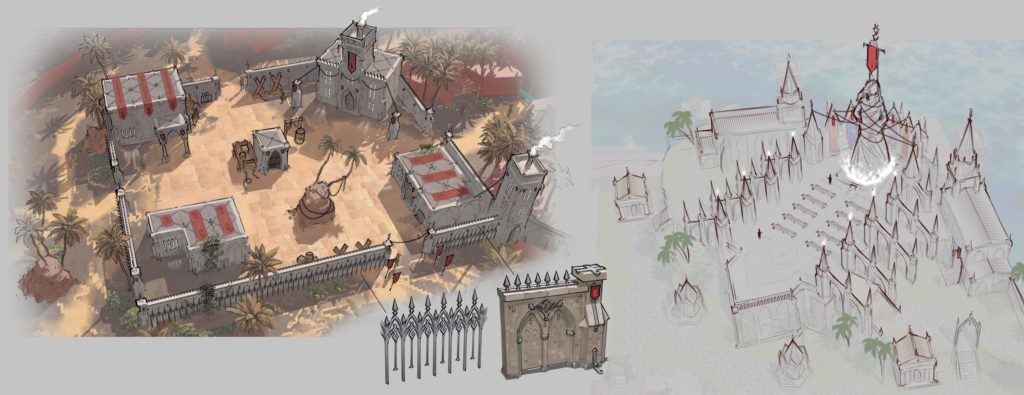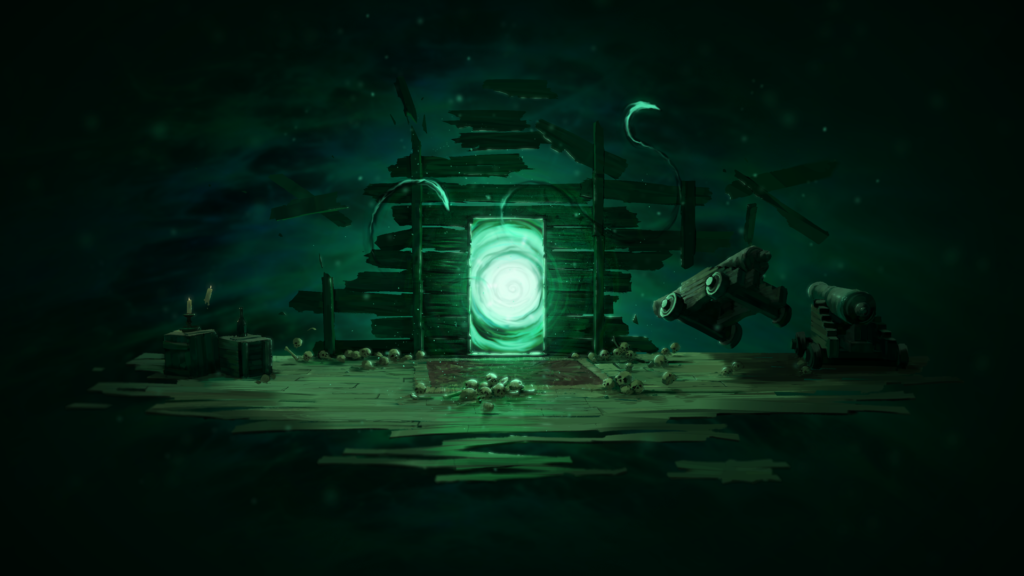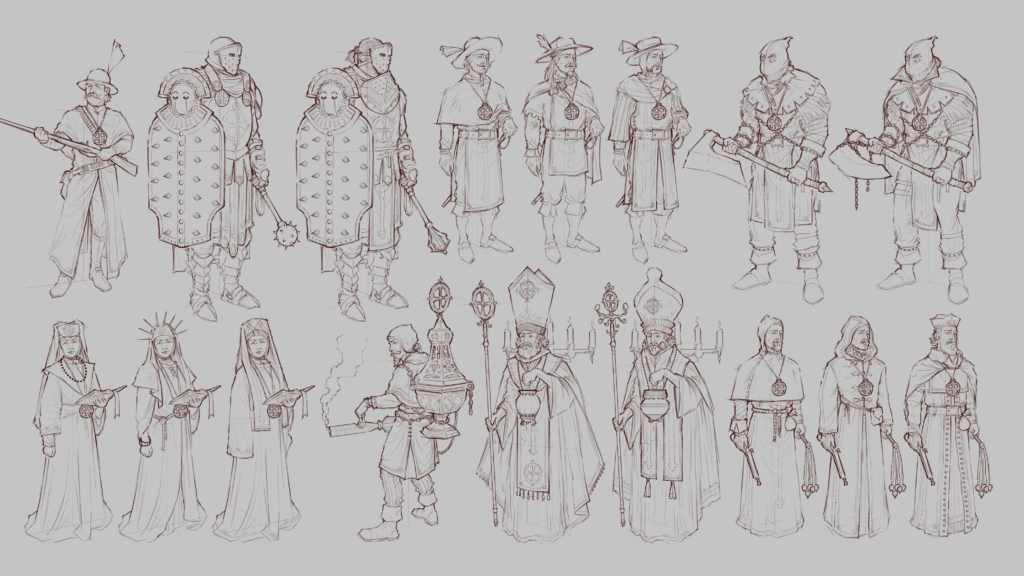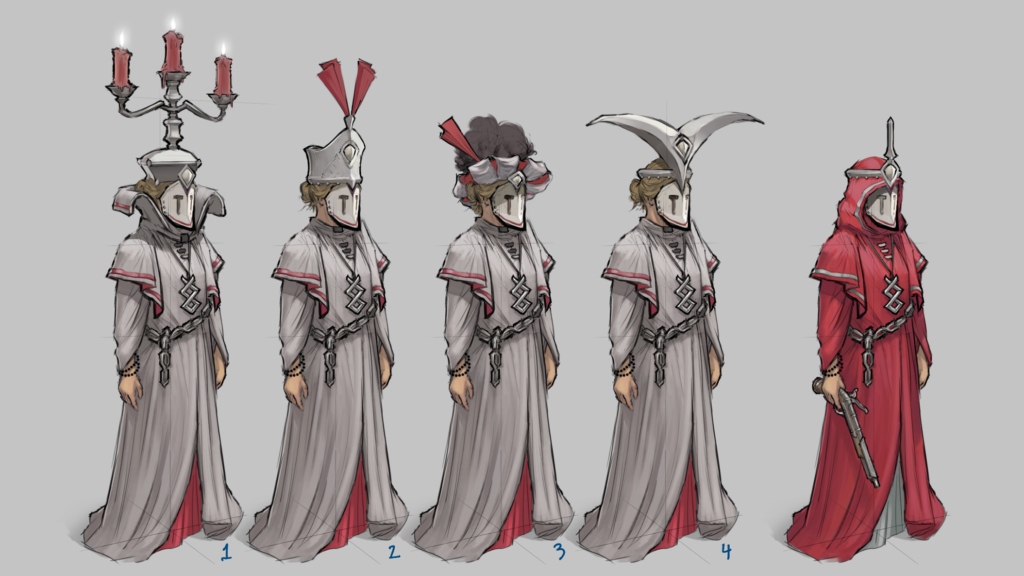Instead of a dark and realistic style, our new Stealth Strategy game Shadow Gambit: The Cursed Crew aims for a more colorful and stylized look. Our artists explain why it fits the game perfectly and how they designed this new magical world from scratch.
Hey, I am Elena and I joined Mimimi Games last year as Communications Manager – you probably already read from me, if you visit this blog or our social media frequently. Now that the cat – or rather the parrot (arr!) – is out of the bag, I want to give our developers a chance to tell you about what it’s like to work on Shadow Gambit: The Cursed Crew and how their ideas and efforts shape the game.
That’s why we created this monthly dev diary blog. After chatting about the pirate setting and the amazing design process of the playable cursed pirate crew, it’s now time to have look at the artstyle and world of Shadow Gambit: The Cursed Crew.
So … how did the game end up with a fresh new look and feel instead of sticking to the art style of Shadow Tactics or Desperados III?
From vague inspirations to Ingame-Look
Naturally finding a new art style for a new game involved a lot of planning and research, as Texture Artist Anisha Fait points out:
“During Preproduction we worked on several ideas and art styles for different pitches. Already during this time a lot of tests and ideas drifted towards more stylized art styles. When starting to work on Shadow Gambit’s art style we first tried to analyze both the strengths and shortcomings of our previous art styles in Shadow Tactics and Desperados III.”
“Additionally we just looked at a huge amount of other media, be it pirate games, isometric games or even movies and paintings to just get ideas from everywhere.”

Finding the perfect look
“We had a lot of meetings in the early phase, where we just sat together with our Pinterest boards (Elena: A popular website that allows you to easily create mood boards with different photos and ideas to visualize concepts) filled to the brim with screenshots and artworks and going over every little detail.”, Anisha continues.
“What we liked, be it shapes, color, mood, textures and what could be beneficial to the goals we wanted to reach with Shadow Gambit’s art style. Slowly we started to get a clearer idea in which direction we wanted to go and our references started to become less broad and more specific. We started to make concepts where we were able to say ‘Let’s recreate this, but 3D!'”
“After this we did several 3D models and textures, doing a lot of iterations on those until we finally had a few assets, where we could say ‘That’s what our game’s going to look like’.”
Where the hell is my character? – Why readability is so important
But why even change the already established art style? According to Anisha, there were multiple reasons to change it up:
“Two main reasons. The first and biggest is readability. In our games that is one of the biggest priorities for us. While we deeply love what we did with Desperados III, we felt like it started to become too noisy. A lot of small, granular detail started to make the screens feel too crowded and the players weren’t able to see as clearly what’s going on with just a few looks at the screen anymore.”
“So we knew we wanted to go with an art style that enabled us to reduce the clutter and noise in everything while still looking beautiful and engaging.”, Anisha explains.
“During research we found that we wanted to go with a more painterly approach to everything and let bigger shapes and colors speak for themselves instead of heavily relying on a lot of detail in everything.”
“Looking at different pictures and paintings we always saw those beautiful, curated and saturated colors that made the important parts pop and gave everything this magical, vacation-y vibe. So for us, using a more saturated and stylized color palette to show those magical places of the Lost Caribbean was a match made in heaven.”

Graphics age but style doesn’t
“Secondly, for us it’s always important that after a few years our games still look good. And graphics age but style doesn’t. Which is why we always try to go a bit more stylized in our games than realism. This time we just leaned a bit more heavily into it.”
At the center of the creation of Shadow Gambit: The Cursed Crew was of course the magical Caribbean world filled with a variety of exotic islands allowing players to explore beautiful beaches, dark soul magic infused places, dangerous fortresses or lively shanty towns. Environment artist Dorian Kirschstein explains how the team brought the different locations to live.
How to design a magical pirate world
“For Shadow Gambit: The Cursed Crew, we created a whole ocean full of the strangest and most amazing islands. After pitching and discussing a ton of ideas, we settled for the ones, that would best tell the tale of the backdrop for our game, aspiring to give each island its own unique character and magical twist. We built the islands in close collaboration between Environment Art and Level Design.”


Environment art meets level design
“While the artist initially focusses on designing a visually believable and awe-inspiring space starring impressive landmarks like exploding lighthouses or giant roots, the level designer would tackle it from the strategic side: Creating areas with varied and memorable gameplay, like a steep wall for a focus on vertical navigation or a beach with shallow water for footprint and noise complicating stealthy approaches.”
“Both concepts coming together, the very first draft of the island is born. From it, a first 3D blocking is created in-engine, and over the span of some months, iteration after iteration, the bonding between gameplay and area themes gets refined to the fun-to-play and great-to-look-at locations you will be able to visit and explore with your crew soon!”

That’s not an easy task but thankfully the designers had a lot of great inspirations helping them to design the world of Shadow Gambit from scratch, as Dorian shares with us.
From Pirates of the Caribbean to Lovecraft
“Not only due to its thematic closeness, Pirates of the Caribbean was an amazing source of inspiration for me. Both conceptually and visually, they managed to give their world the lighthearted deepness we wanted to have for our game.”
“As a game experience, Assassin’s Creed: Black Flag supplied me with the pirate-y feeling of exploration and sense of wonder, while being more on the realistic side of things. Which is not necessary a disadvantage, as some of our wildest ideas are actually based on real-life marvels: like the biggest Inquisition stronghold in the game for example, which is heavily inspired by the castled island of Janjira in India.”
“And finally, a certain Lovecraftian touch cannot be denied, when you’re exploring the space-colored deeper decks of the Red Marley…”

Similar to the Black Pearl in Pirates of the Caribbean the Red Marley plays a big role in Shadow Gambit. She is more than just a ship due to her living soul and the ability to manipulate time. She can stop or reset it in order to help the crew out while fighting the Inquisition of the Burning Maiden. Concept Artist Lucas Reiner explains how he designed her as a spooky and interesting looking pirate ship, but also as a cozy home for the crew.
The Red Marley: How the ghost ship became a home
“In my first attempt at the Red Marley, all I wanted to achieve was a likeable, rudimentary, cozy home for our crew, where each crew member would have their own personal little territory on deck decorated with assets that represent them, where the player would be able to see them work and hang out.”
“Although none of the crew members themselves had been finalized at that point, a few character ideas were already there and those characters’ areas are present in the earliest rough concept. You can find the Japan-themed tea table there that belongs to the skeletal ship cook Toya, as well as the alchemist desk of ship surgeon Suleidy who is half plant half woman and always ready to patch the crew up. If you look up, you can also see the lookout where the blind sharpshooter Teresa takes aim from.”

When Look and gameplay go hand in hand
“We later decided that the ship’s masts and surfaces should be broken into pieces and just barely be held together by magic, with planks and various bones levitating in mid-air to support the magical aspect of the Red Marley and its crew.”
“This ‘targeted destruction’ also allows us to eliminate some obstacles that would normally block the player’s view. If a solid wall is covering up something we really want you to see, we can just break that wall to give the camera an unobstructed angle, killing two parrots with one flintlock pistol.”
“Aside from that, the two most notable magical additions in this step included the giant skeleton hugging the ship’s bow and the notorious skeleton duo later named ‘Pete and the nameless one’ positioned on the ship’s stern.”

Of course, we already talked in depth about the character design of the cursed crewmembers as well. But another important part of the look and feel of Shadow Gambit: The Cursed Crew are the bad guys – the fanatic order of the Inquisition trying to oppress everything related to soul magic in the Lost Caribbean.
The Inquisition: History meets fantasy
“The inspiration here is quite obvious and partly in the name: The Spanish Inquisition. For a concept artist, this means spending many hours researching the history of the real-life Spanish Inquisition, as well as pop culture references. I discovered that while their infamous red robes were mostly contrived by the popular Monty Python sketch, the color suits any enemy faction perfectly – and it’s probably the color we would have used anyway.”
“I intended for the design of their clothing to show some of their cruelty and religious dogmatism, while sprinkling some fantasy elements in there too, like spiky headdresses, weapons and candles. Keep in mind that at this stage only a few details about what the Inquisition stands for and who they worship etc. had been put forward by the writers, so I had to remain rather vague.”

“The addition of metal helmets and masks impacted the design greatly, as from a lore perspective it takes away from each Inquisition member’s individuality and humanity, as well as simplifying the development process down the line since we would not have to create different faces, facial hair variations etc.”
“Surprisingly, I was able to use most of the ideas from the very first concept sheet for months to come, using it as a reference to kick-start many future enemy types’ designs.”

We hope you enjoyed the insights our artists gave you, if you want to learn more about Shadow Gambit in general, you can check out the links below:
JOIN OUR CREW
☠️ Join our Discord if you’d like to chat with us and our growing Mimimi community.
☠️ You can also follow us on Twitter | YouTube | Twitch | Facebook | Instagram |TikTok to stay up to date.
☠️ And we have a Newsletter if you’d like to receive updates directly from us by e-mail.
See you soon on the high seas!
Elena



